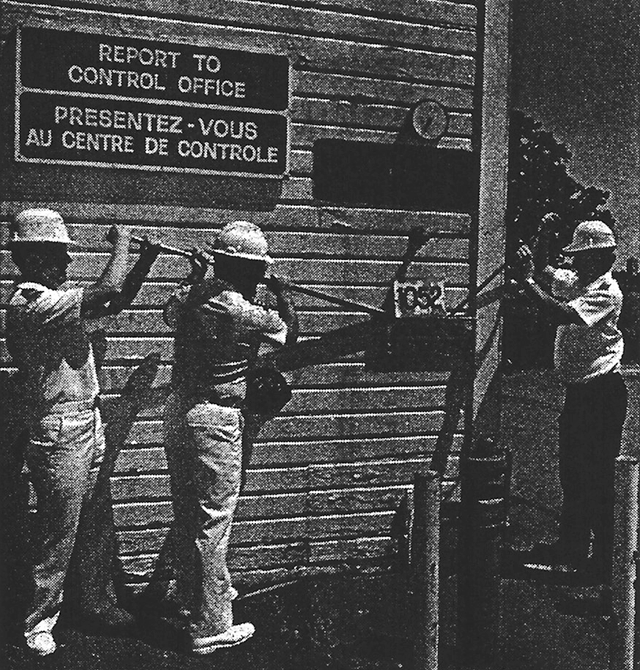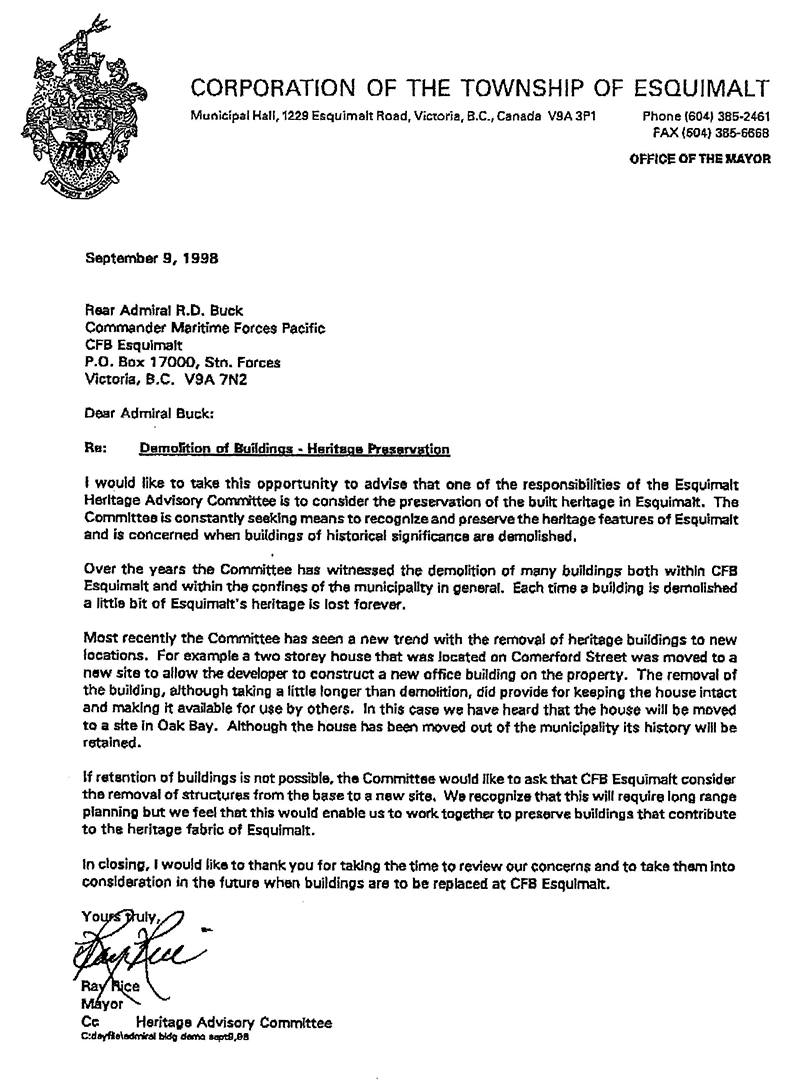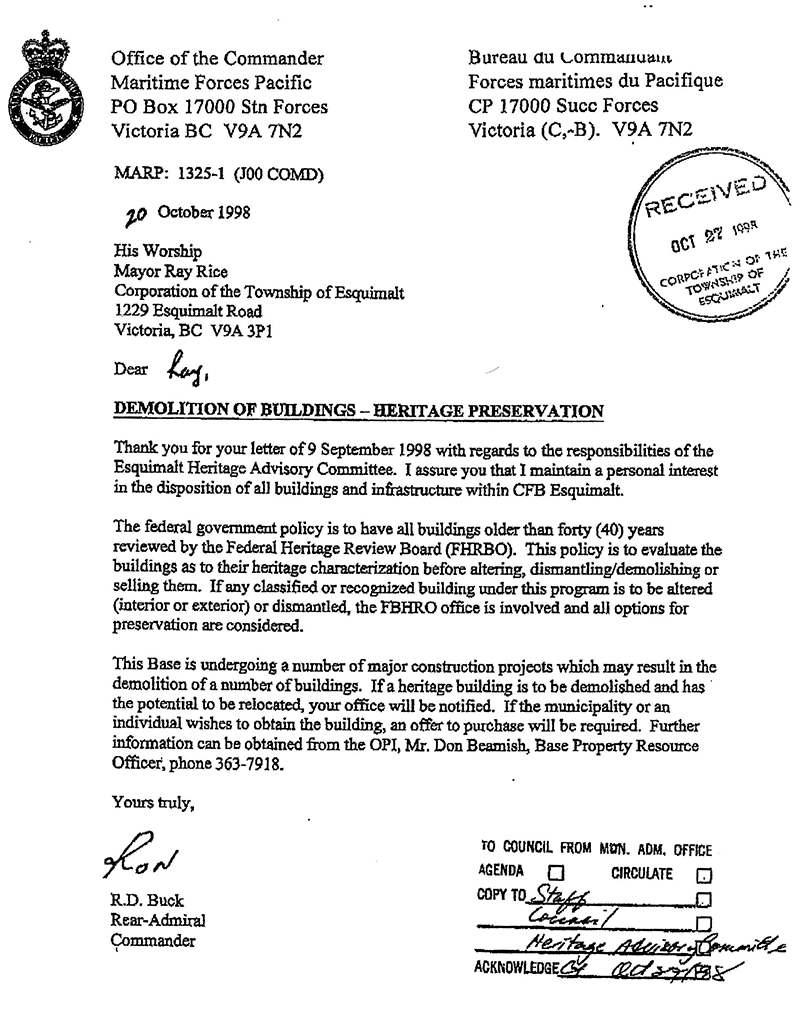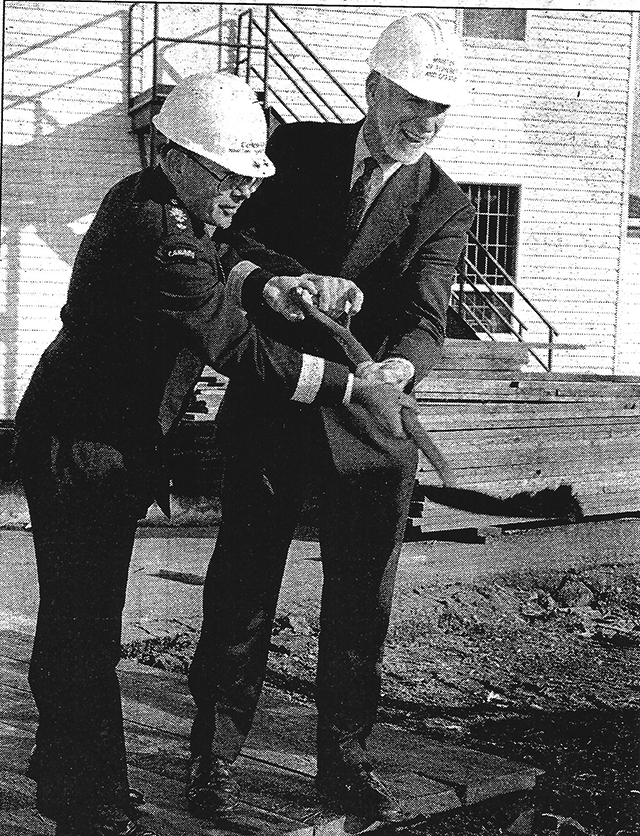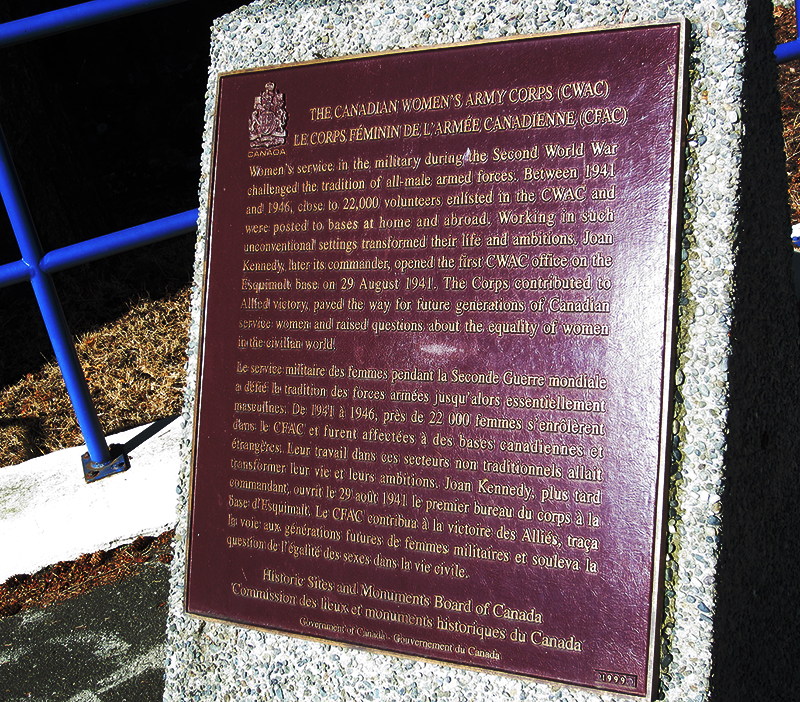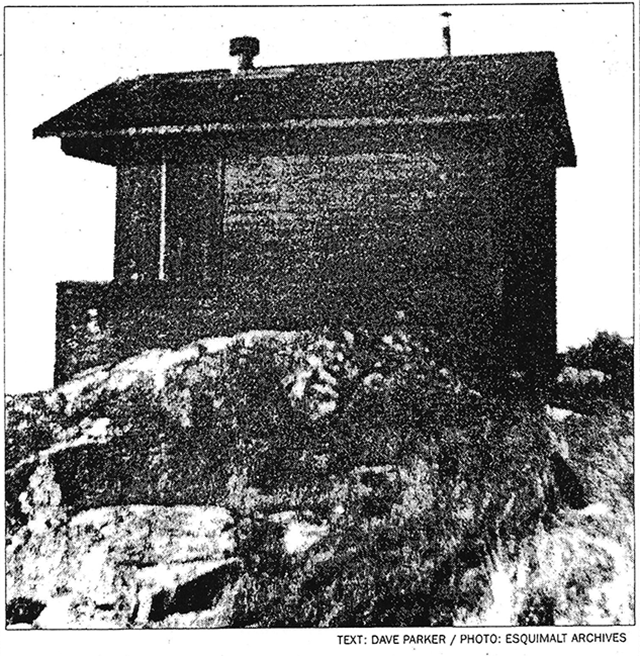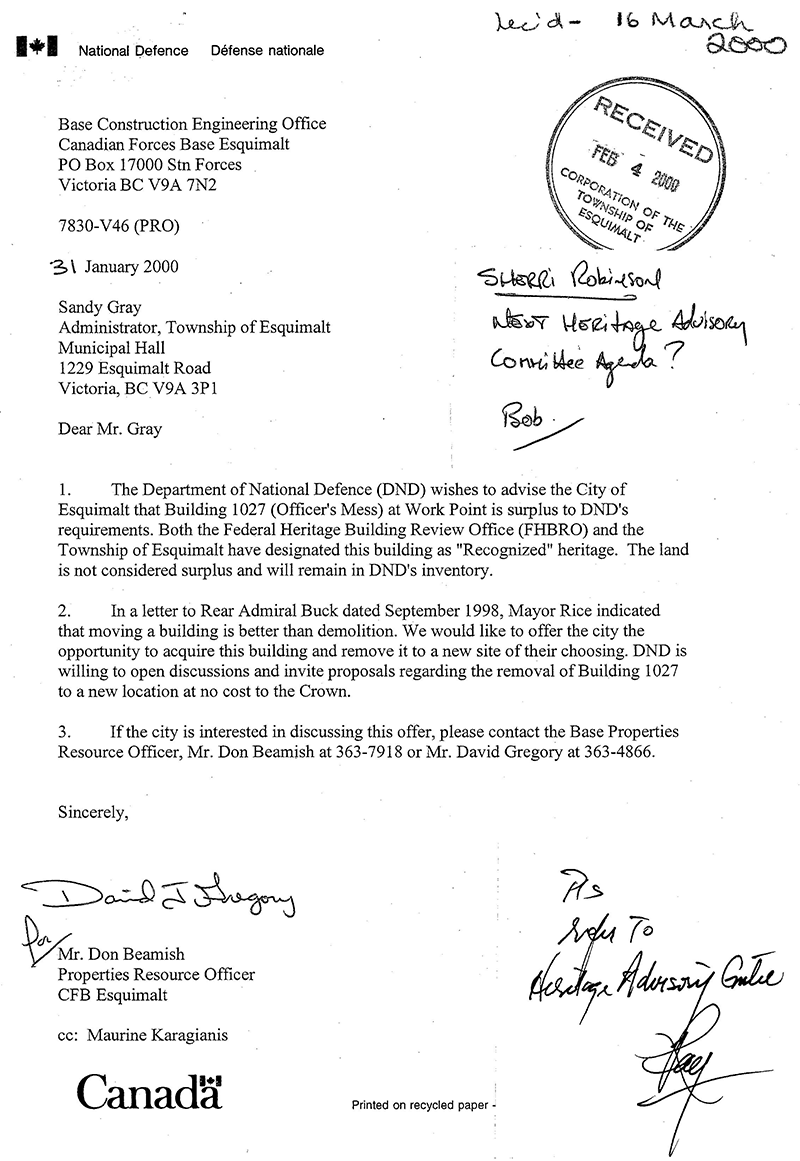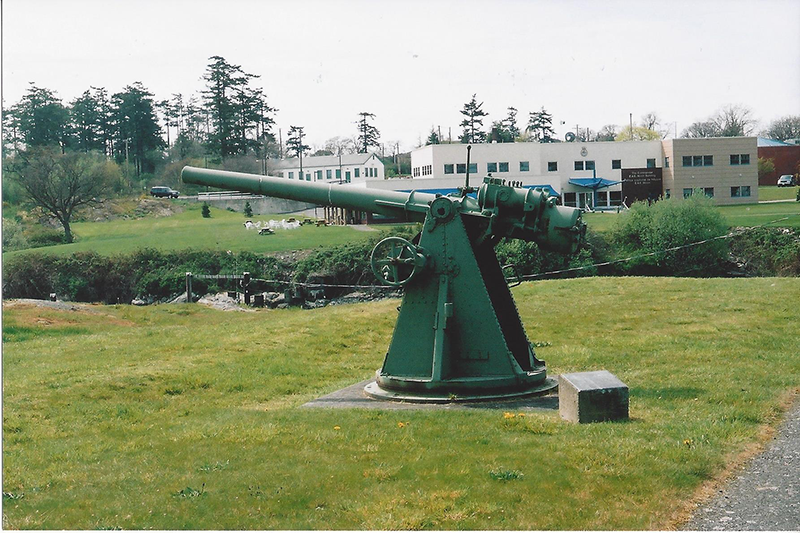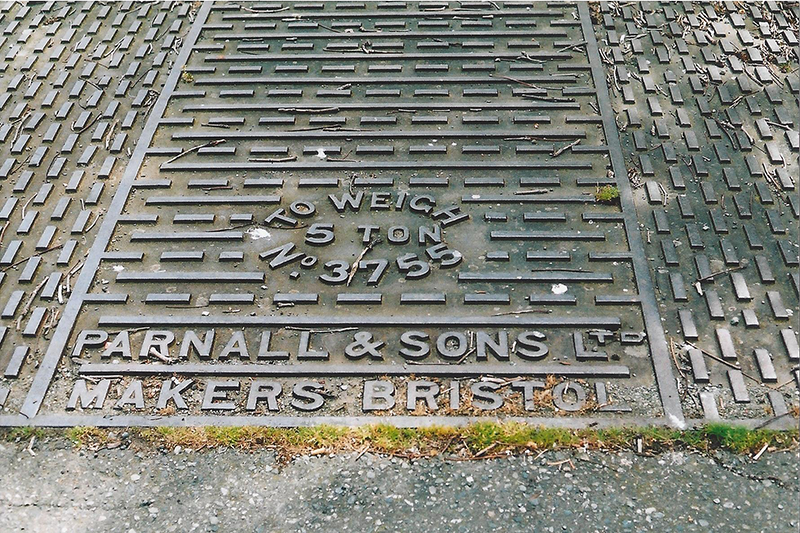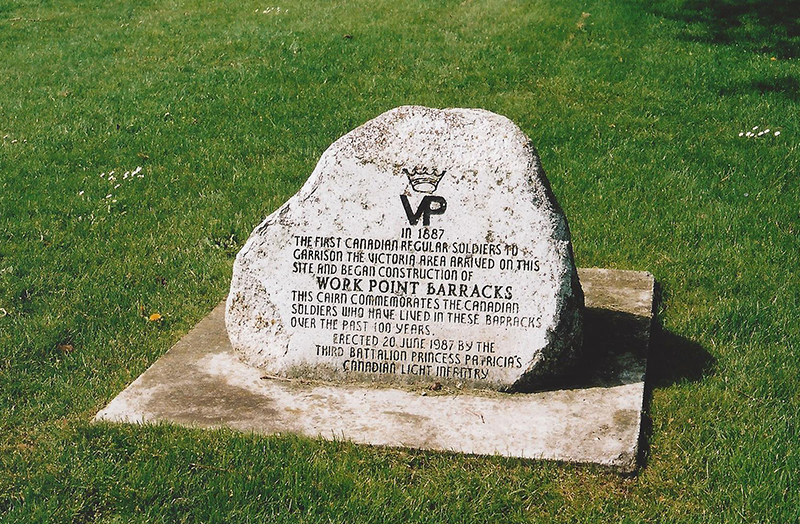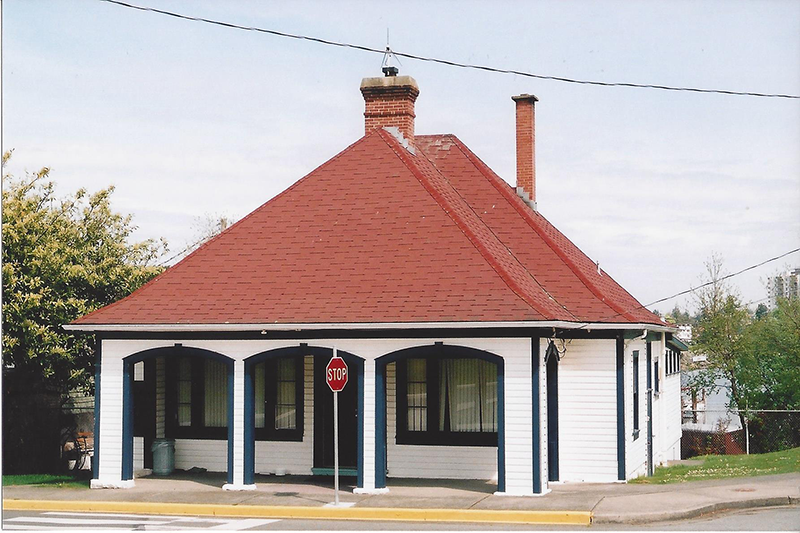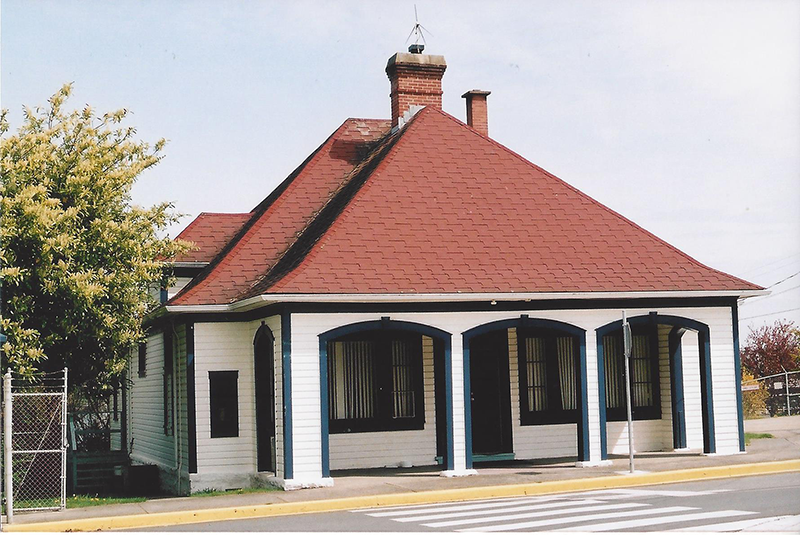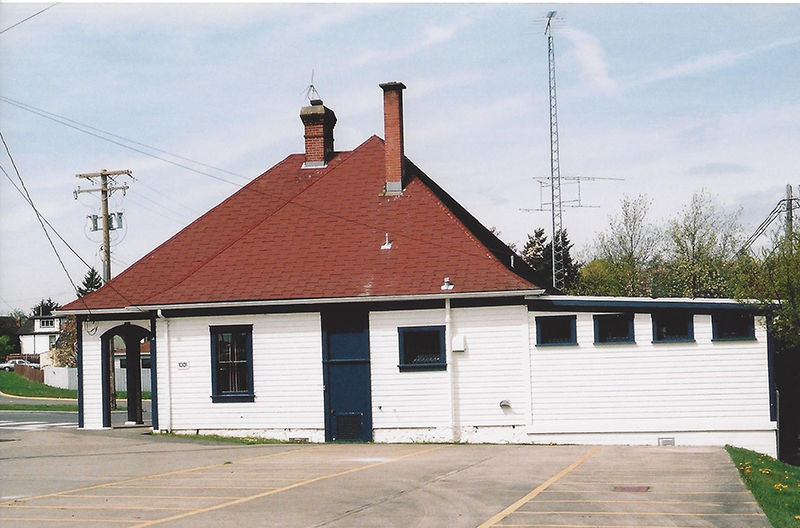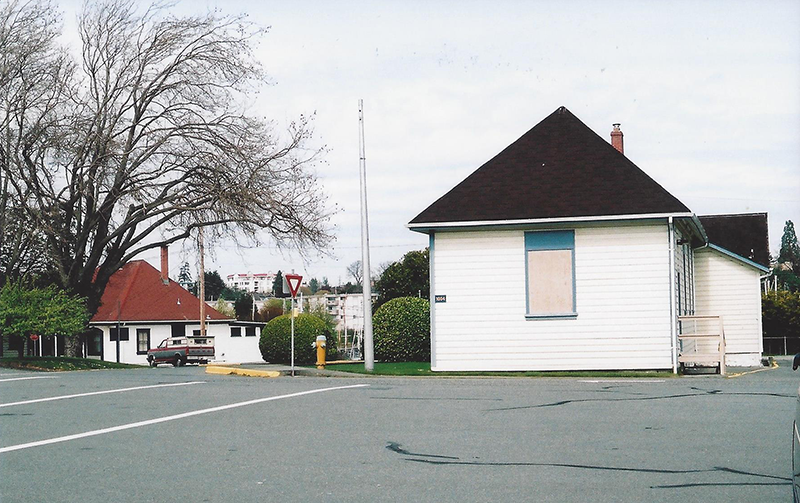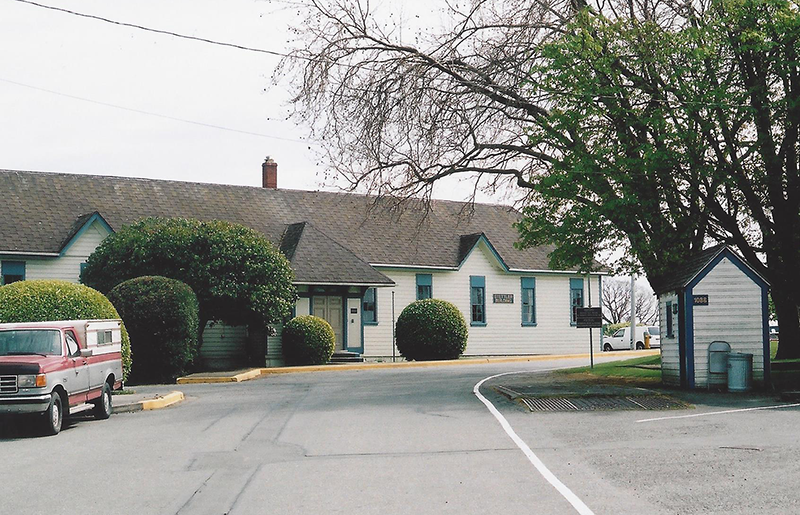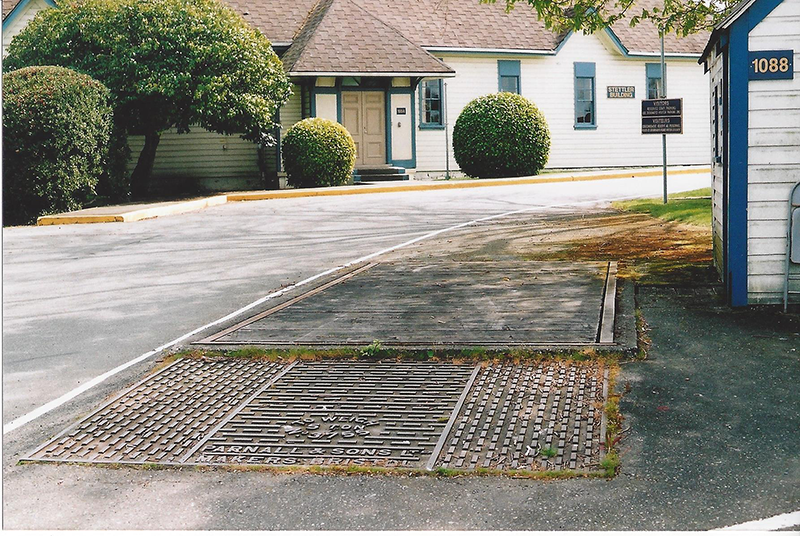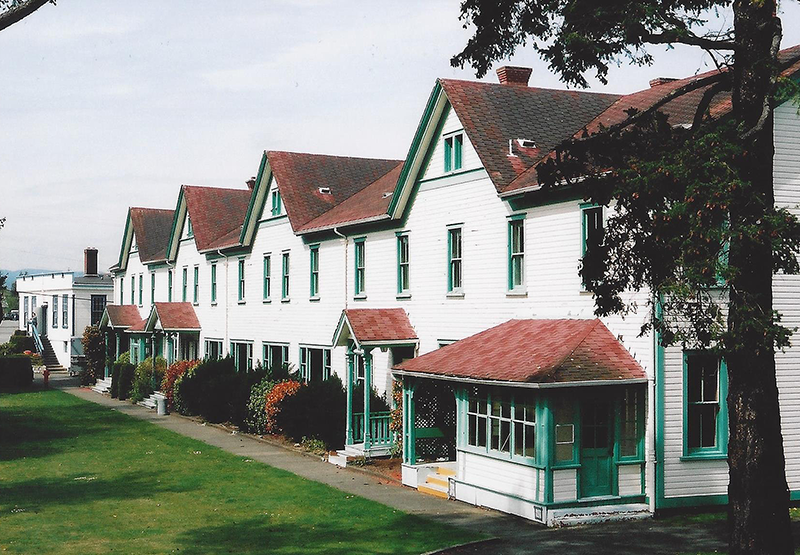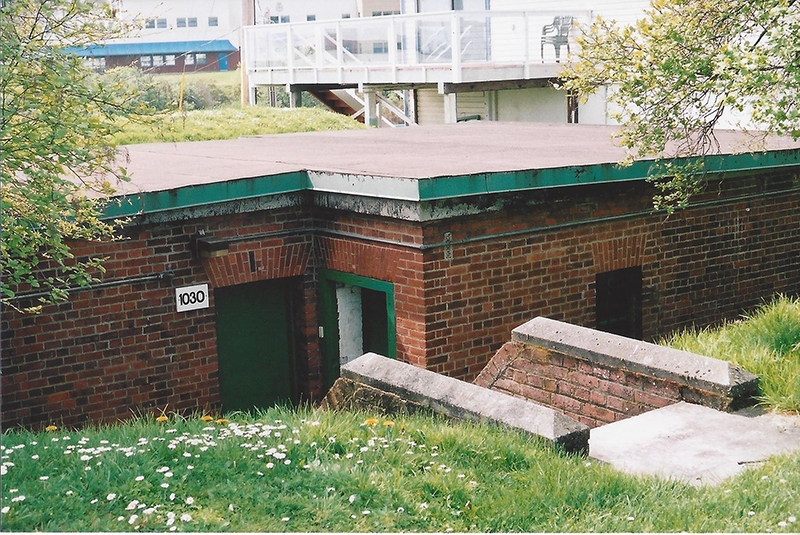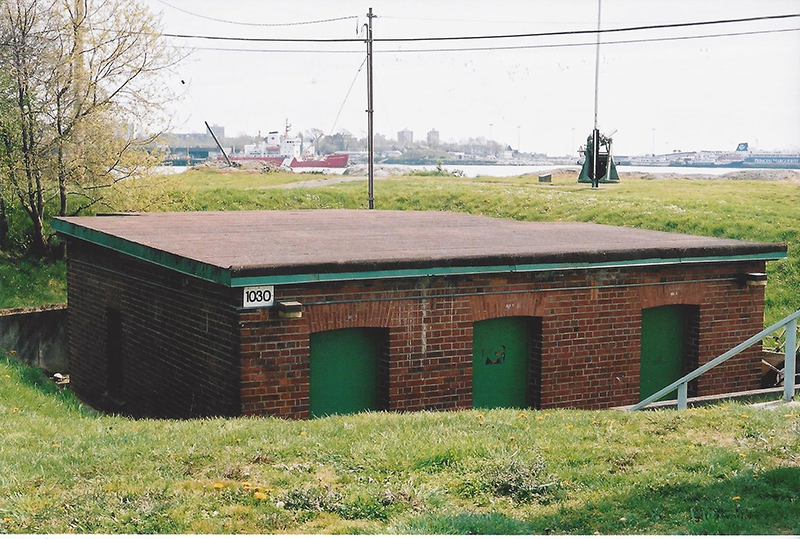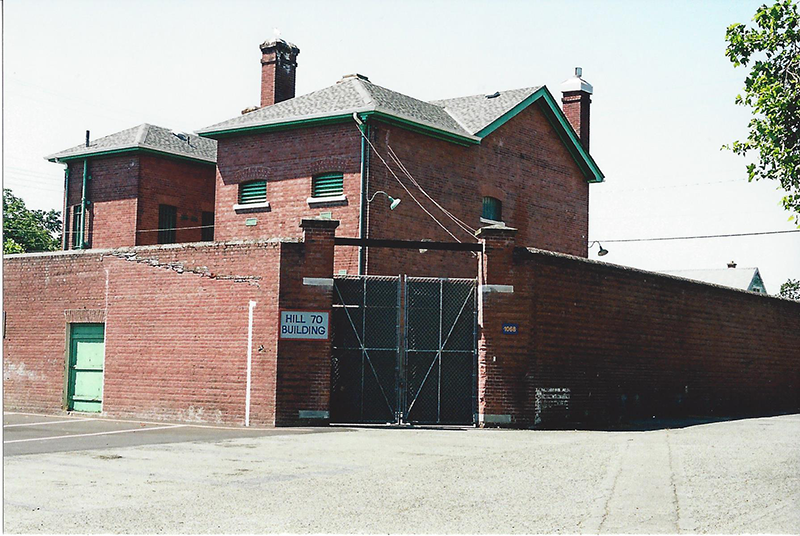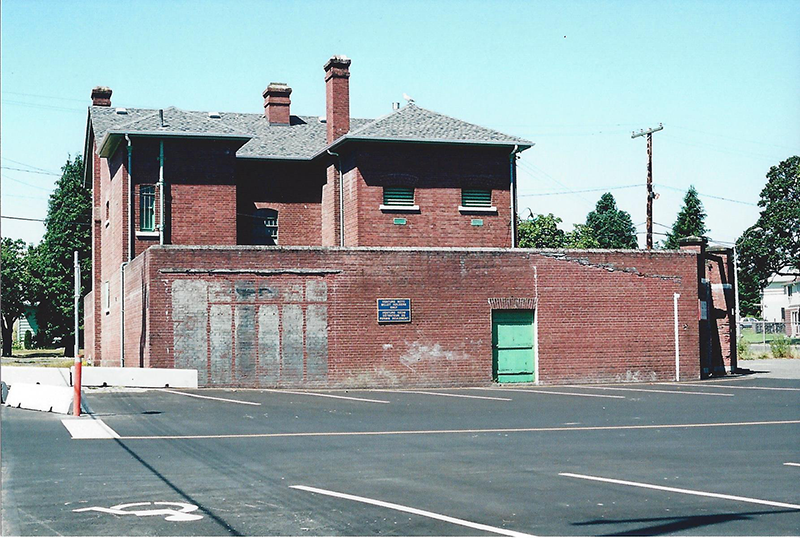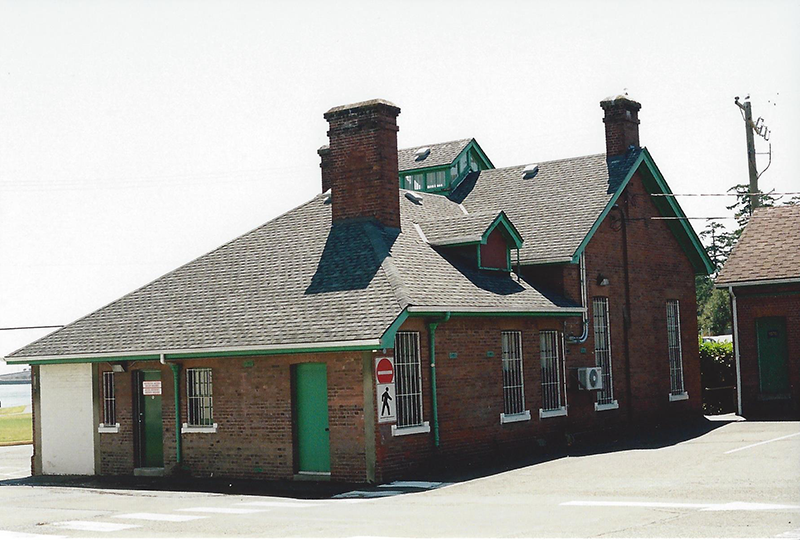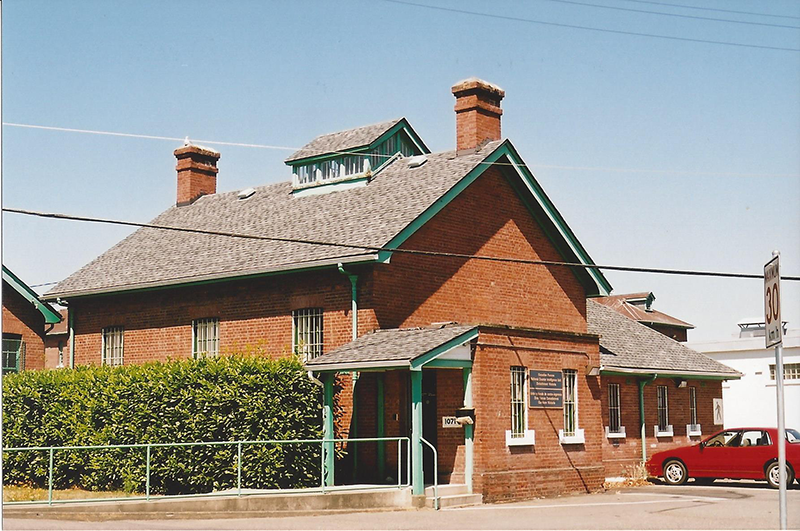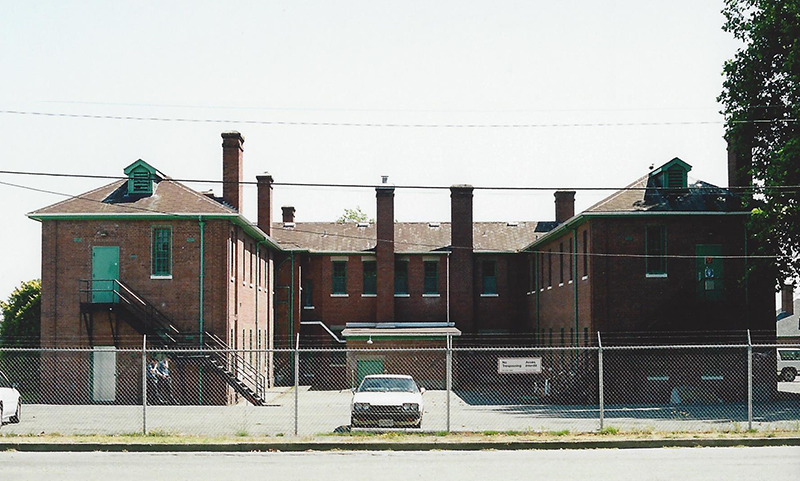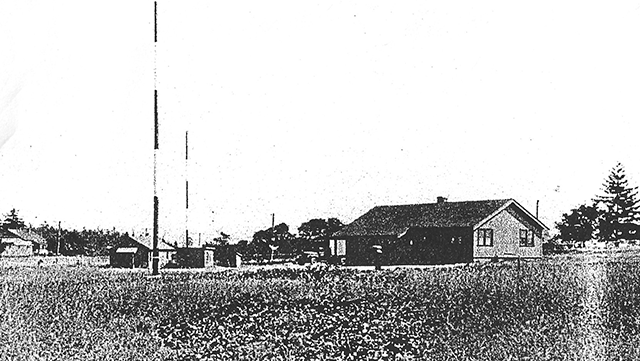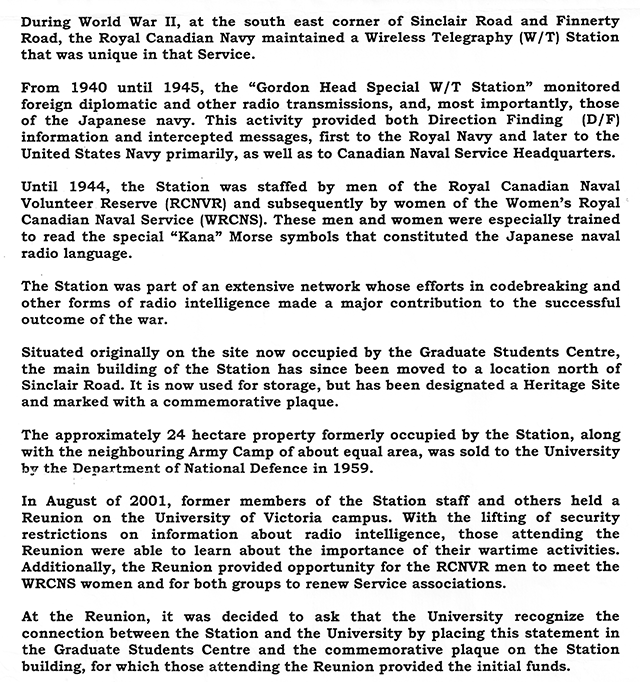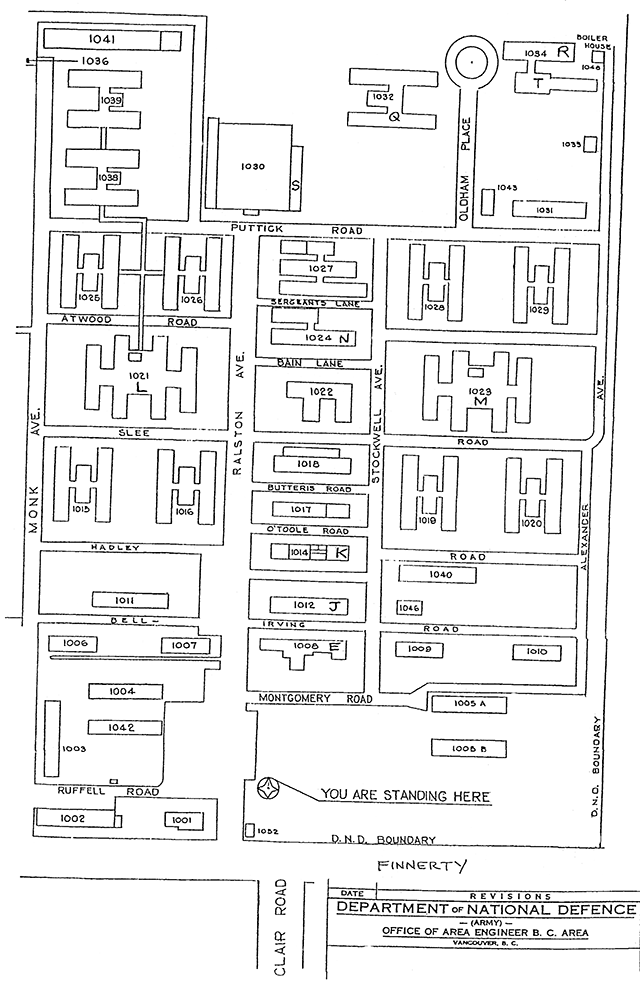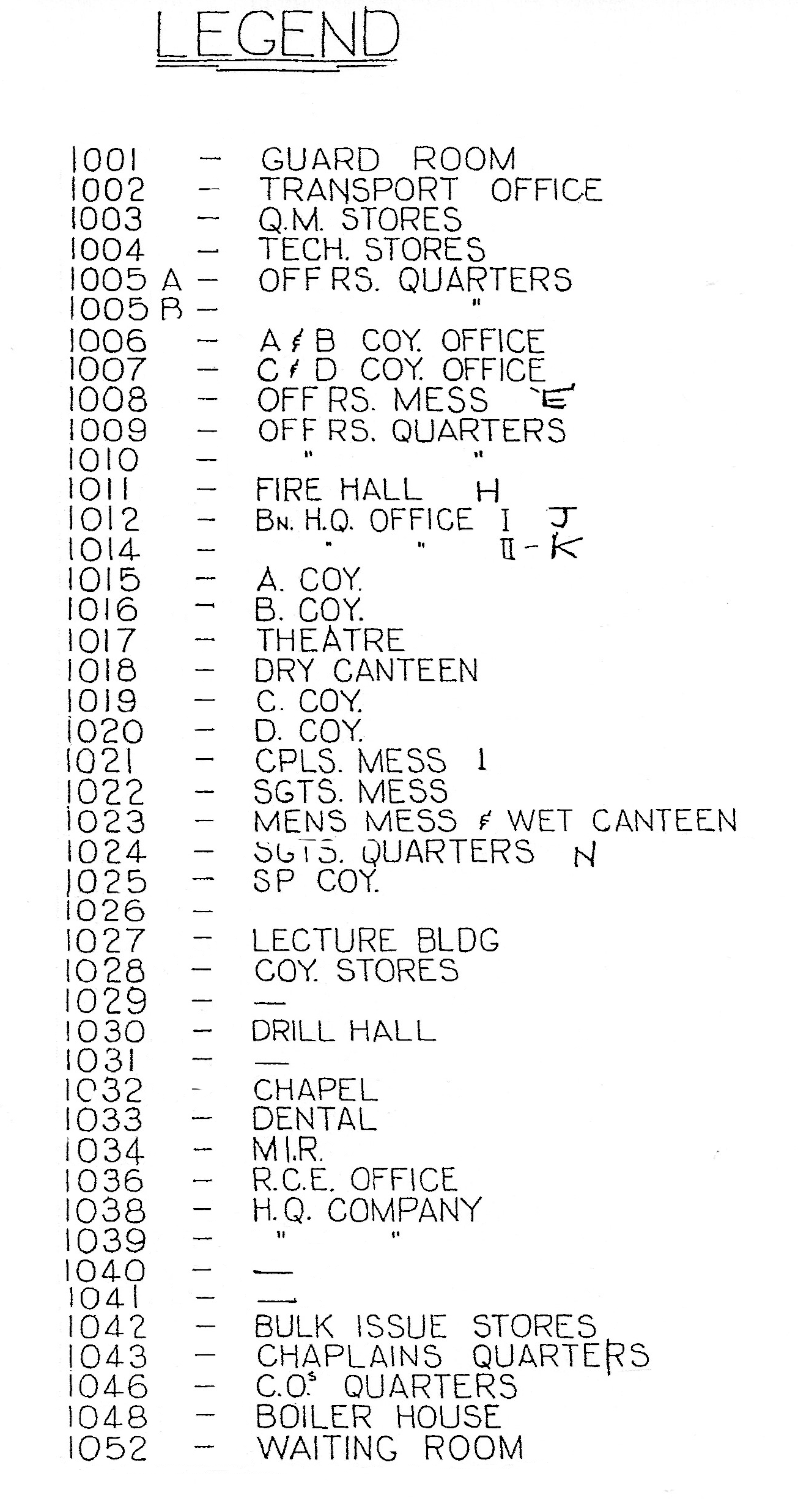 |
 OPCMHVisitor No.: |
HISTORY OF WORK POINT BARRACKSby Jack BatesPART 10 — 1995 to 20221995ESQUIMALT NEWS IN 100 YEARS HARBOUR HAS COMPLETELY CHANGED
In the 1880’s Esquimalt was a small town of a few hundred inhabitants in whose harbour the ship of the Royal Navy and the merchant fleet found safe anchorage. The dog-legged main street, called Wharf Street, ran down to the sea. It was a quiet town of wooden dwellings, stores and pubs. The school, which started out sharing the same building as St. Paul’s Church, was about to have its own building near the new church. The most unusual thing about Esquimalt was the presence of the Royal Navy establishment and the most exciting thing happening was the construction of the drydock. That was a very big project which brought much activity and many people, with new expertise, to the little community. Of course, Wharf Street was not so tranquil when a ship was in harbour. In their traditional way, sailors raised the activity level on the street as did merchant seamen when they arrived. Also, local outfitters were busy with new shipments of much needed merchandise. Anyone with a horse and cart was busy transporting passengers and goods back and forth between Esquimalt and Fort Victoria, as it was still known. The postmaster was run off his feet receiving and sending overseas mail. The post marks were exotic including San Francisco, Manchester and Ballarat, Australia. And, of course the pubs were busy – serving beer, renting rooms and cooking meals. John Howard was a prominent citizen of Esquimalt. He owned a hotel on Wharf Street. He was the postmaster and he owned horses and carts and even a carriage. It was through looking at his property holdings that we, at the Municipal Archives, became curious about his history. Some of his property moved into the hands of Mrs. Howard, then Helen Crump. Because few women held land in Esquimalt at this time, we became curious about her story. Then we noticed that John Howard was still alive. The story began to unfold in strange and wonderful ways, even extending to include noted architect Frances Mawson Rattenbury. Then we found a file of letters in the British Columbia Archives and Records Service collections that filled in many of the details of this complex story which certainly proves yet again, that truth is stranger than fiction. Thursday, February 22, at 7 p.m. in the Esquimalt Branch Library, Sherri Robinson will present “Tales of Passion and Intrigue in Old Esquimalt Village,” based on Archival research and a file of personal correspondence that reads better than any novel. Articles researched and written by Archives staff and volunteers. Photo from the Tom Brunsden collection. PPCLI NEWSLETTER VICTORIA BRANCH Again, warm spring greetings from balmy Victoria. The disbandment of the Airborne Regiment caused heated discussion at our last two meetings. Shame on those shifty politicians that were involved with this ill conceived decision ! Friendly advise for the Chief of Staff; consider banning the use of the video camera within the Armed Forces. It has demonstrated to be a extremely hazardous device and future use may cause more mayhem. The Navy has established itself firmly in Work Point Barracks, depositing large anchors in front of the old Bn H.Q. Building. The one time Officer’s Mess is presently a “Wardroom” and again to loudly proclaim its new ownership, large Ship’s Bells adorn the entrance hallway. On this last day in February, the demolition of the “temporary” wooden structures, erected in the early 40’s, full of memories, has started. Our home, off and on for more than 30 years, the WO’s and Sgt’s Mess, stands mutely, gutted, awaiting the wreckers. Presently we hold our meetings in the Passchendaele Building, the old Master Corporals Club. It also has a date with the wreckers in the near future and perhaps for that reason has been spared the adornment of anchors and ship’s bells. End November we held our Branch Annual General Meeting at Work Point Barracks and our new executive has a few new faces; Chick Goodman has replaced Doug Bell as Vice-President, John Tolley taking the vacant position of the secretary, Mrs. Olive Miller is the new entertainment chairperson, George Humiston retains his seat as the Sick and Visiting member, Charles Faye remains as Sergeant at Arms, and Bruce Dickey is our branch Heritage Councillor. To Doug, who served for three years on the executive, thanks, we surely will miss your sober judgement and wise council. On 16 December, in conjunction with the Korean Veteran’s Association, we held our annual Turkey Bingo. Thanks John, for doing an excellent job as CQMS! On 17 March, the Victoria Branch held their Regimental Birthday celebration in the Passchendaele building at Work Point Barracks. There were 71 members in attendance. Messages of regret were read from Cammie Ware, who is working hard to recover from his recent illness, and from John Loy, who on doctor’s orders could not attend. Earlier in the week, the Colonel of the Regiment, MGen Bill Hewson, almost made it to sunny Victoria, but sightings of Spanish warships off the coast of Newfoundland sent him back to frigid Ottawa. In any event, the birthday cake was cut by Frank McBride and the party was done in true Regimental style. On behalf of the membership, thanks to the Entertainment Chairperson, Mrs. Olive Miller and her committee as well as Georgina and Don Worsfold, Bill Fisher, Ed McDade and John Tolley who worked hard to make this a successful evening. IN MEMORIUM DOUGLAS “DOOGIE” PRECCE – Born 13 July 1926, passed away in Calgary on 28 November 1994. DONALD “DAN” MASSIE – Passed away in Victoria after a short illness on 02 December, 1994, both Doogie and Dan were longtime members of the Victoria Branch. JOHN LINDSAY “JACK” RENNIE – aged 79 years, passed away after a lengthy illness. Jack was a longtime supporter of our branch.
COLONIST AIRBORNE AFTERMATH ARMY ADDS THREE PARACHUTE COMPANIES The Canadian Press – Ottawa The now-disbanded Canadian Airborne Regiment will be replaced with three separate parachute companies, each serving as a nucleus for a new light infantry battalion. That will give the army nine regular battalions — up from six — three of which will contain a parachute-trained company. The new units will help ease the strain of peacekeeping duties by spreading around the burden. Gen. John de Chastelain, chief of defence staff, said Wednesday the 150 member airborne companies will be stationed at Petawawa, Ont., Edmonton and Valcartier, Quebec. Starting in September, the bulk of the men will likely come from the ranks of the former Airborne Regiment, he said. The new light infantry battalions of 600 to 700 soldiers each will grow around the companies. A white paper last December promised 3,000 extra soldiers for the mary’s (army’s) fighting end. This is the first expansion. It's good news for Canadian peacekeepers, said Lew MacKenzie, a retired General. “With the pace of rotations, some guys are back for their fourth tour in Bosnia.” It’s welcome news for Petawawa, on the fringe of the big military base that used to house the Airborne. Reeve Ed Chow said business in the little town has been hurt by the deployment of peacekeepers from the base. “We’ve, in effect, lost a great number of our people in the last few years to peacekeeping duties. We’ve already felt an economic impact.” Bob Lockhart, Canadian Airborne Association president, called the action a political compromise. In the 1960’s, each of the three regular regiments maintained an airborne company. In 1968, they were amalgamated in the Canadian Airborne Regiment. That outfit was ordered disbanded last January 23 after a series of disciplinary problems, including the broadcast of several unsavory amateur videos. De Chastelain said the army needs a parachute capability. For isolated regions, that means paratroopers. He stressed the difference between parachute and airborne capability. The Airborne included anti-air units, artillery support and engineers. The parachute companies will basically only be trained to jump. Esquimalt News Esquimalt Has No Claim To Macaulay Point Esquimalt has no entitlement to any of the land at Work Point or Macaulay Point. So says municipal clerk Bob Seright, who recently presented a report to council on the history of the land. “The information seems reasonably conclusive that the municipality has no right of first refusal over the properties,” Seright told the News. The Federal Government expropriated 163 acres of land at Work Point and Macaulay Point from a number of private owners and the municipality in 1942 during World War II. According to Seright’s research, the Federal Government paid Esquimalt $80,533 for the portion of land it expropriated from the township. Seright said it’s interesting to note that the Federal Government consolidated all of the Work Point / Macaulay Point land it expropriated during the Second World War into one lot. The Department of National Defence (DND) is currently examining how much of the land at Work Point it needs. October 4, 1995 Out of the Past Macaulay Point Has Been a Hot Topic For Some Time Ever since the Municipality of Esquimalt was formed, the Work Point / Macaulay Point lands have generated a considerable amount of discussion on council. The Macaulay Point Golf Course was originally constructed in 1893 by a detachment of the Royal Marine Artillery and was operated under the name of the United Services Club. In 1922, the United Services Club relocated and changed their name to Uplands Golf Course. Around that time the Macaulay Golf Club was established. In the late twenties or early thirties, Esquimalt acquired the lands due to the instability of the Golf Club to pay the taxes. In 1934 the lands were finally transferred to the municipality. In October of 1934, the municipality leased the land back to the golf club for a five year period at a rate $1,000 per year. In 1939 the Federal Government took this property and the club became dormant until 1943, when members called a meeting and decided to go into voluntary liquidation. Information indicates that any records of the golf club were lost when the club house of the Victoria Golf Club burned down. These lands and other adjacent lands were purchased by the Federal Government in September 1942 for $80,533.33. At the same time, Work Point / Macaulay Point lands were acquired by the Federal Government through expropriation during World War II in 1942. The Federal Order in Council reads: “The expropriate officers of the army service are of the opinion that the privately owned properties with the exception of Imperial oil Limited property, the lands owned by the municipality and the streets vested in the municipality together with all shore rights pertaining thereto should be acquired by the Crown.” “The Real Estate Advisor has examined the properties in question and recommends that lands and streets above described (about 163 acres) be expropriated by the Crown and is of the opinion that a fair price by way of compensation should not exceed $ 225,000.” In 1964 Esquimalt wrote to the Department of National Defence to determine if it could be given any right of first refusal to purchase any Crown Lands that may become surplus. In a response, the deputy minister of defence replied with a letter, stating: “... this department would not be in position to grant the right of first refusal in the matter of purchase. Normal procedures dictate that when property becomes surplus to department requirements, it is transferred to Crown Assts Disposal Corporation for disposal action. I understand that, if there is no other federal requirement for the property, preference is given to provincial and municipal bodies before it is made available to the public.” On May 9, 1995, Defence Minister David Collenette had a similar very response when Mayor Chris Clement requested information on a timetable to return Work Point lands to the public and private sectors. “The Department of National Defence is examining its holdings, including the role of Work Point, in terms of the department’s long term needs. Until these requirements are established, the land will not be declared surplus. Your interest in the site has been noted in our property inventory and you may be assured that, if the site is declared surplus, your interest will be documented on the formal Notice of Excess which would be sent to public Works Government Services Canada. It should be noted that federal government policy dictates that all transactions with regard to real property owned by the Crown must be conducted at fair market value.” On September 2, 1986, the Federal Government consolidated all the lands acquired by expropriation during World War II into one lot. The Macaulay Point lands are currently used by the municipality under an agreement between the Department of National Defence and Esquimalt. The agreement provided Esquimalt with a licence to use and occupy these lands, as a municipal park for recreational and historical interest purposes. The amount of land covered by the agreement is about five hectares and the agreement runs for five years from April 12, 1991. See March 3, 1940 for another thought on the golf course closure. Historic Sites and Monuments Board of Canada The “Esquimalt Naval Sites National Historic Sites of Canada” was officially dedicated on November 24, 1995. It consisted of HMC Dockyard, the Royal Navy Hospital, the Veteran’s Cemetery and Cole Island. 1996Times Colonist Work Point - New Life Looms For Old Barracks CFB Esquimalt is exploring its use as a movie set or Olympic training centre Esquimalt’s Work Point Barracks, once the home of Vancouver Island’s full time soldiers, could become home to movie producers and Olympic athletes. CFB Esquimalt is exploring options presented by both the Commonwealth Centre for Sports development and the film industry, base spokesman Lieut. Dave Scanlon said Wednesday. Work Point offered accommodation to officials during the Commonwealth Games. The sports proposal, which might see Commonwealth rowers and swimmers use the base as a training facility, is a spinoff of that, Scanlon said. “We think there’s a good chance that we can support two Olympic teams – both swimming and rowing tams – in our spare capacity,” Scanlon said. Work Point which has a gym, track, barracks and cafeteria, seems to be a natural for an athletic training facility. Using the site is just one of the several options being considered by the sports centre, said Ken Shields, president of that organization. The centre, a legacy of the Commonwealth Games, was set up to promote Canadian sports programs. “We’ve had exploratory talks with Saanich, with the University, with Camosun, with Royal Roads, with the school districts – everybody in Greater Victoria – to get a feel of what the resource base is,” Shields said. Meanwhile, CFB Esquimalt has the idea being considered by the Federal Treasury Board. The base is also considering vacating a large electrical maintenance building for use by the film industry as a sound studio, Scanlon said. “The thing is, we’re still using it. We know there’s a good chance we may not need it down the road so the question is can we move out sooner?” Scanlon said. The electrical mechanical engineering shop is about half the size of an arena, with high ceilings. Victoria film commissioner David Mills said there are a number of Victoria businessmen who are interested in developing a sound stage and the Work Point building, again, is one option. “The Admiral (Bruce Johnston) wants to open up the base and become film friendly in order to help build the industry in Victoria. He sees an opportunity …to create jobs,” Mills said. Cost recovery and even the prospect of generating revenue for the cash starved military are factors that have to be considered, Scanlon said. “I don’t think (generating additional revenue) is the prime motivation, but I think certainly it is a motivation,” Scanlon said. “There’s a lot of pressure on all federal departments and particularly DND to do business in the smartest possible way.” Work Point was the home of the 3rd Battalion Princess Patricia’s Canadian Light infantry until 1993, when the battalion move to Chilliwack. Since then, the base has moved its naval officer training program to the army base and regularly uses the barracks to house training officers and reservists. Esquimalt News CCSD, Film Industry Both Eye Barracks Olympic athletes cruising through Esquimalt ? Hollywood producers hobnobbing with locals ? Don’t laugh, it could happen since CFB Esquimalt is “working hard” to come up with a plan that would see both the Commonwealth Centre for Sports Development (CCSD) and the film industry as future tenants at Work Point Barracks in Esquimalt. “We have surplus land at Work Point so it would be crazy for CCSD and the film industry to go off and build facilities when we capacity,” CFB Esquimalt commander Capt. Stan Verran recently told the News. He added the base is negotiating with the CCSd to have Work Point used as a training facility for Olympic-calibre athletes. Work Point was used to house officials during the Commonwealth games. Work Point – with its gymnasium, track, barracks and cafeteria – would be an ideal training site, noted Verran. He said the film industry is considering converting a large maintenance building at Work Point – that the base may vacate – into a sound studio. MLA Moe Sihota also supports the idea of housing athletes and the film industry at Work Point. He added that he has indicated his support to the Federal Government. “We have the ability, because our climate to attract elite athletes who could train all year round and there seems to be a good level of interest from the Feds. The Federal Government is anxious to get rid of land it doesn’t need or get more money from the buildings it does have at Work Point,” said Sihota. He also pointed out that “a number of producers” have told him that they have “scouted out Victoria as a possible location for filming but they’ve never filmed here because there aren’t the facilities here that they need.” But Base spokesperson Dave Scanlon says, so far, the possibility that Olympic athletes will be training at Esquimalt and feature films produced in the community are “still pie in the sky.” Work Point is just one site that both the CCSD and film industry are considering, he noted. July 10, 1996 Hollywood of the North II? An Unused Building at Work Point Barracks Victoria is a few steps away from becoming a major player in the Canadian filmmaking industry and Esquimalt could be the big winner, says Ian Ferguson, co-chair of the Victoria Film Council. Ferguson predicts 1,000 new jobs and a cash injection of $100 million within the next three years if the film council – a group of civic boosters that included CFB Esquimalt base commander Stan and Esquimalt Mayor Chris Clement – can lure filmmakers into Victoria. One of the essential ingredients in attracting filmmaking to Victoria that the area currently lacks is a local film studio. Council members, including Ferguson and publisher David Black, have ponied up a million dollars for construction of a movie studo large enough to shoot indoor scenes, notes Ferguson. He adds that the studio will include sound stages and a special effects area that could be located in Esquimalt. The council is considering several sites around Greater Victoria for a studio, including an unused vehicle maintenance building at Esquimalt’s Work Point Barracks. “The support we’ve had from the Federal Government and from CFB Esquimalt base commander has been phenomenal. And right now we’re about 60 days away from a green light,” noted Ferguson. CFB Esquimalt isn’t the only group interested in assisting the council. The Povince and municipal governments recently agreed to “team up”with the council to help transform Victoria into a “film friendly” community. Last year, BC was was the fourth largest movie production centre in North America; movie producers spent $400 million in BC and hired close to 8000 full time workers. Those numbers will continue to expand by 20 per cent a year, says Ferguson, adding that he feels Victoria will be poised to take a big chunk of that lucrative scene with with the addition of a film studio and government employment programs. “We’ve come an awful long way although there’s still a lot of things that need to be done,” he admits. Filmmaking is a labour intensive industry that requires crews who possess skills in a wide variety of trades and while the area has the talent to produce commercials, we still lack a labour pool that is capable of tackling feature films, Ferguson points out. He says a new provincially-funded program is being developed to train 230 people in various aspects of film making. The province has not yet relealeased any detail about the size or or nature of its commitment to the filmmaking business. But Ferguson believes such details will soon be straightned away and “in the next three months there will be visible signs of the industry taking root in Victoria.” Another knock against Victoria has been its reputation for being too inflexible when it comes to accommodating filmmakers. Some filmmakers have found they’ve had to meet city inspection codes even for buildings designed simply as hollow-shell props. To address the concerns of filmmakers, the Greater Victoria Chamber of Commerce has created a one-stop office and a one-page application to deal with film permits. Transportation to and from Vancouver Island has also been a problem and BC Ferries has responded with an assured loading policy for filmmakers who regularly travel with tons of equipment. The CCSD, Commonwealth Centre for Sports Development, did utilize the gymnasium and the next door sports field in 1996 and into 1998. A number of the athletes took up residence in the Work Point barrack blocks and ate in the mess hall. This was the forerunner to the current Pacific Institute for Sports Excellence. FHBRO Report 96-096-(F) Click here to view report as a PDF (very large file). 1997CANADIAN NAVAL REVIEW Continuing Canadian Naval Officer Training in the 21st Century This publication covers the Introduction, History, Transformation, Today and The Future in paragraphs regarding the Naval Officer’s Trainging Centre now established at Work Point post 3PPCLI departure in June 1994. It relates to the buildings at Work Point and the renaming of the Brig. J.A. de Lalanne Building (WP 1094) opened January 31, 1989. Dedication rights of the building were transferred to 3PPCLI in Edmonton and it was renamed the Vice-Admiral A.J. Collier Building on December 12, 1997. WORK POINT BARRACKS A Flagstaff and Ship’s Bell was rededicated as the “VENTURE MAST” and was placed outside the Vice-Admiral AL Collier Building, WP 1094, in Work Point. The NOTC School flagstaff which now stands in front of the building was originally the mainmast of the training schooner Venture. The mast had previously become the flagstaff for the newly opened Naval Training Base, HMCS Cornwallis in 1943. With the imminent closure of CFB Cornwallis in September 1994, concerted efforts by many retired and currently serving Venture officers ensued that this naval artefact was preserved at NOTC on the west coast. The mast came down in Cornwallis in April 1995 and was delivered to Halifax for transfer to Esquimalt in HMCS Huron. The mast was refurbished at CFB Esquimalt and NEU(P) in the Dockyard, and was set in concrete in November 1997 shortly after the NABS opened. The entire facility was dedicated as the Vice-Admiral A.L. Collier Building on December 12, 1997 by Vice-Admiral Maddison.
1998Grant Keddie An archaelological report by Grant Keddie on First Nations defensive sites in the Macaulay Point / Fleming beach areas are referred to as DcRu 20 and DcRu 21. The Lookout Venture Buildings Renamed Navy names are appearing on buildings at the Naval Officers Training Centre (NOTC), Venture, Work Point Barracks. Work Point barracks, named after local luminary and early pioneer John Work, has housed artillery and infantry units since 1887. The Third Battalion of Princess Patricia’s Canadian Light Infantry was stationed there from 1970 to 1994, when the navy moved in. Most of the buildings have been named with army history in mind. With the shift to a navy operation there is also a shift to naval names. The galley, formerly known as Korea Hall, has been renamed after HMCS Bonaventure, Canada’s last aircraft carrier. Bonaventure was in service from 1957 to 1970. The three accommodation blocks have been renamed Ojibwa, Oakville and Rainbow. HMCS Ojibwa, the oldest of Canada’s three Oberon class submarines, is still in service on the east coast. HMCS Oakville is one of the most famous of Canada’s World War II corvettes, earning Battle of the Atlantic honours. The cruiser HMCS Rainbow, commissioned in 1910, was Canada’s first naval warship. Several more buildings will be renamed over the coming months. New street signs at the corner of Lyall Street and Strange Avenue suddenly appeared a few years ago, in blue, with anchors, and renamed in French: “Rue Lyall” and “Rue Strange”, and others: “Rue Anson St,” “Rue Vaughan St” “and “Rue View Point St.” A little over zealous don’t you think .... Speaking of street signs, poor old Macaulay had his name misspelled many a time over the years, the south west corner street sign perpetuates this, “Macauly” and Lyall. July 27, 1998 Demo Days at Work Point After three full years of deliberations, Monday, July 20 marked the first tangible activity for Defence Services Program Project C4544, Upgrade NOTC Facilities. RAdm Russell Moore, Capt (N) Dave Marshall and Cdr Bellows officially initiated the demolition phase of this major construction (recapitalization) project. This phase will see 11 buildings removed from the construction site at Work Point over the next several weeks. DND will then turn over a cleared site to the successful contractor, whose mandate will be to design and build a new training support centre (NOTC) beginning this fall. Demolition contractors will be “destructing” the buildings, as opposed to demolishing them. This move is keeping with the bases’ evolving sustainable development strategy, which seeks to reduce or eliminate the volume of demolition debris that goes to the land fill. Material with salvage potential will be sold as the buildings are taken apart, and rubble will be used as fill to the greatest extent possible. The first phase of Project C4544, valued at just under $4 million, involves the demolition and new construction work, as well as landscaping to provide a small sports field adjacent to the new building. The new 2,200 square metre facility, which will lie across the street from the VAdm Collier Training Centre, will accommodate the NOTC officer and his headquarters staff, who are currently housed in the former Princess Patricia’s Canadian Light Infantry (PPCLI) building. A multi-purpose drill deck, change room and showers, and a new gunroom will also be feature elements of the new building. Ben Levinson, a local architectural consultant, has been working with NOTC and the NDHQ Project team, LCdr Clive Orford, project director, and Mr. John Laverdiere, project manager, over the last six months to clarify the facility and site development requirements in a tender document. Authorization has been granted to secure the contractor, and that process is already under way. Contract award is expected in October. The follow on phase(s) of Project C4544 are now under development.
Capt(N) Dave Marshall and RAdm Russell Moore started the demolition process of NOTC building 1052. Buildings down by September ’98 were #’s: 1032, 1033, 1040, 1041, 1044, and 1052. # 1043, the Flanders Building, was taken off site by house movers Nickel Bros. and barged to Hornby Island destined to be a B & B. # 1049 was also demolished after1998 as were 1060, 1062, 1359 (TB 14), 1059 and 1064. COLONIST ISLANDER Article Pending TOWNSHIP OF ESQUIMALT
BASE COMMANDER
1999The Lookout Minister Announces Projects New Infrastructures — Year in Review (1998) With a golden shovel in his hands and the Admiral by his side, David Anderson, Minister of Fisheries and Oceans, shovelled a scoop of ground to mark the construction of a new training centre in Work Point. Minister Anderson was at CFB Esquimalt on October 15, on behalf of the Minister of National Defence Art Eggleton, to announce the creation of a variety of projects totalling $30 million, and to commend the divers from Fleet Diving Unit Pacific for their work with the Swissair 111 crash in Halifax. “I was at Peggy’s Cove a week ago, and I want you to know that the work done by the people from the West Coast has been enormously appreciated. I want to say how proud we are of the 35 Navy divers from Fleet Diving Unit Pacific that were a part of the response team,” said the Minister during his speech. The $3.26 million contract to build the new Naval Officer Training Centre’s (NOTC) multi-purpose building was awarded to Knappett Construction Limited of Victoria. Facing opposite Venture, the 2,000 square metre facility will house administrative and training areas, and is expected to be up and running by September of next year. The other announcement made by the Minister is a new officer’s accommodation and mess facility to be built on Signal Hill across the street from the Chief and Petty Officer’s accommodations. The 54 year old Wardroom, the current home for officers, is considered “out of date” and inefficient, and provides 27 per cent of the total requirement for officer’s single quarters. “We believe it’s important to improve the quality of life for our service men and women; and we believe improving operational support is equally important in our stewardship of the defences of Canada. It was true way back 150 years ago and it’s true now,” said Minister Anderson. The Minister also touched upon three other projects already underway: the Maritime Coastal Defence Vessel 160 metre jetty and the shore based replenishment at sea trainer both nearing completion, as well as the damage control and fire fighting trainer in Colwood. “These construction projects demonstrate the government’s commitment to ensuring that the Forces have the equipment and facilities they need to support operations, personnel and training.” After the ceremony, the Minister toured Venture and tried his hand at manoeuvring a ship in the navigation and bridge simulator used to train the navy’s junior officers and ship’s command teams.
Through a team effort, Minister David Anderson, Minister of Fisheries and Oceans, and R Adm Ron Buck, commander MARPAC, announced the creation of a new $3.26 million naval training support facility at Work Point. The two made the project official with a groundbreaking scoop of dirt on Thursday, Oct. 15. July 19, 1999 Construction Venture Building Steadily E.A.E. Nixon Building The unusually wet winter has pushed back the opening date of the Cdr. (E.A.E.) Nixon Building in Work Point. The actual completion date was to be Sept. 15, but heavy rainfall slowed construction, says CPO1 Dave Windle, Naval Officer Training Centre (NOTC) coxswain, who predicts occupancy to be no later than Oct. 15. A few namesakes were considered for the building, including Admiral Walter Hose, suggested by Dr. James Boutilier because he was the man who single handedly saved the Royal Canadian navy in the penniless and pacifistic 1920’s. But Edward Atcherley Eckersall Nixon has a wide and justified reputation as the father of the Royal Naval College, says Dr. Boutilier, and has been described by many as the driving force behind the college. Nixon was extraordinarily conscientious and attentive when it came to raising his charges as officers and gentlemen,” says Dr. Boutilier. “It seems fitting [to name the building after Nixon] given the fact that his career in the Canadian navy was virtually spent training junior officers,” says CPO1 Windle. The $3.98 million administrative and training building includes a 2,000 square metre building with office space for 22 people, a training floor for drill, a large classroom, a student lounge and a small sports field that over looks the Victoria harbour. It’s right across the street from the Collier Centre, which puts administrative staff a few steps from the teaching staff, says CPO1 Windle. “The footprint for NOTC is definitely moving in that direction,” says CPO1 Windle from his current office in building 1020. “Once we move, it will open up a whole area of Work Point [not in use].” In a few years, he anticipates the demolition of his current vintage office along with the officer’s mess, as well as the remodelling of building 1091 for classrooms and the gutting and refurbishing of building 1092 into a French language training centre. “In a couple of years people might not recognize Work Point,” he says. The new building is # 1367 and contains the Gun Room, a delightful location within Work Point. Historic Sites and A bronze plaque was placed at Naden in Museum Square commemorating the origin of the CWAC at CFB Esquimalt on August 29, 1941. Of course the reference should be that the CWAC, as commanded by Lt. Col. Joan Kennedy, was first located at Work Point Barracks, specifically in building 1020. The H S & M B of C is aware of the mis-reference but maybe assumed or was advised that Work Point will disappear. Wishful thinking by some! The FHBRO 89-205 report awarded no points for persons/events category! However, coincidentally there is a CWAC display within the military side of the museum. Her diary and photographs are held in the Ashton Armoury Museum collections.
2000Esquimalt Archives Proud Past ... Promising Future Few of us today would associate Saxe Point with the defence of Esquimalt and Victoria, but during World War II it was. Though not as impressive as Dockyard, Fort Macaulay, Fort Rodd Hill, or William Head, it was still a component of “Fortress Victoria.” Coastal and anti-aircraft artillery – the latter is now termed “Triple A” – were features of the landscape during the war as were mobile and fixed searchlights. It was necessary to camouflage the installation from the enemy as well as to protect both the searchlights and crew from the weather. The building shown housed a single large searchlight which could project its beam out into the Strait. It was the basic knowledge that, in order for defending artillery to be effective and make things unpleasant for an enemy warship, gunners first had to find the target. Powerful searchlights, in the days before radar acquisition were very necessary. See Esquimalt Star June 3, 1987 for more on Saxe Point Park.
TOWNSHIP OF ESQUIMALT
WORK POINT These photos I took around Work Point this day.
WORK POINT These photos I took this day around Work Point.
CANADIAN MILITARY TIMES The Ross Rifle: This should clear up any mysteries about the Ross Rifle in World War 1. Click for PDF. 2001LEONA TAYLOR FILES EVENTS COMPILED FROM THE BRITISH COLONIST BY LEONA TAYLOR October 22, 1846 - July 26, 1923 Click here to view events as a PDF The Islander A Petticoat Army This article written by Sidney Allison is about the CWAC and its founder Joan Kennedy. A point to recognize here is that the CWAC headquarters offices were in the Administration Building # 1020 in Work Point Barracks at the time. The building is in-tact to this day however I have not been able to ascertain which of the many offices was used by Lt. Col. Joan Kennedy. A Historic Sites and Monuments Board of Canada (based in Ottawa) plaque outside building # 39 at the CFB Esquimalt Naval and Military Museum references that the CWAC originated at CFB Esquimalt, however, to be specific, the location of the headquarters was at Work Point Barracks. Click here to view a PDF file of the above. CFB ESQUIMALT WORK POINT BUILDING 1027 Click here to view report by Lt. Cdr. C. Orford as a PDF Lookout Work Point Pathway Changed Phase one of the waterfront pathway from Macaulay Point to Work Point has taken another turn as the Base Commander and Esquimalt mayor work to resolve married quarter (MQ) resident’s concerns. The plan now is to build the path from the abandoned coastal battery up the west side of the pistol range and end it at Vaughn Street. The solution re-routes it away from the MQ area and Anson St. “My understanding is it now meets all the resident’s requirements and concerns over the location of the path,” said Base Commander, Capt. (N) Adrian Round. Residents first voiced their concerns in a petition, and again at a town hall meeting with the Base Commander, after they discovered a sod turning ceremony taking place in their neighbourhood April 12. Safety and privacy issues were foremost on their minds, especially if the second and third phases go through connecting downtown all the way to Macaulay Point. Residents said the increased traffic could bring undesirable people into their community, and Macaulay Point is already a hangout for youth. Capt. (N) Round encourages them to call the MP’s whenever there’s a disturbance on the DND shoreline property; it’s the best way to snuff out the problem he said. Phase two of the pathway, which would wind around MQ backyards, will not go through, but Capt. (N) Round told Mayor Ray Rice he’ll consider the last phase that connects the West Bay Walkway to McLoughlin Point near the Naval Officer Training Centre (NOTC). These options will need to be discussed with NOTC staff and the Work Point Community Council to ensure concerns are heard prior to approval being granted to proceed, said Capt. (N) Round. Construction for phase one has already started, and the Base Commander asks residents for their patience as trucks pass through the neighbourhood. It’s the only access to the construction area, he said. READY AYE READY Perched on the south-eastern tip of Vancouver Island, Esquimalt was guarding the Pacific coast a decade before Canada was born. It has played a pivotal role in the history of the country ever since. Some of Canada’s newest naval recruits start their basic training on the country’s oldest commissioned ship, the Oriole. They get a taste of life before the mast and an introduction to the colourful history of the country’s biggest naval base, Esquimalt on Vancouver Island. Canadian Forces Base Esquimalt’s historical past will be highlighted in an upcoming 30-minute episode of HistoryLands to be broadcasted on History television May 26, 2001, 8:30 p.m. EST. In June 2000, CFB Esquimalt opened its doors to a film crew from Good Earth Productions Inc., a production house based in Toronto, Ontario, who filmed on Base. The resulting video focuses on the base’s historical importance to Canada as well as Maritme Forces Pacific’s contemporary role. The documentary is expected to feature the Commodore’s Residence for……. I did enjoy the production, and noted it was only the Navy guarding the Pacific coast and firing the guns from Brother’s Island. However, my “old chum” Doug Nelson made an appearance. COLONIST LAND CLAIM DELAYS PUT HERITAGE SITE IN JEOPARDY Native land claims and economics are combining to make it difficult to ensure the future of a 19th century building at CFB Esquimalt. Some local artists are hoping the old officer’s mess at Work Point Barracks could be turned into a professional arts centre. Colin MacLock, a professional artist and illustrator and one of the forces behind the plan, said the building could be subdivided into studio, office and meeting spaces for rent. MacLock said the end result could be a centrepiece of an arts precinct and a new face and economic force in the community. But Don Beamish, the civilian property manager for the base, said it’s going to be difficult to come up with any workable plan for the building. In the end, the best solution may be just to move it to another site. The building was completed in 1890, and originally housed the artillery units assigned to guard the harbor. Most recently it was headquarters to the Third Battalion, Princess Patricia’s Canadian Light Infantry. After the PPCLI moved, it was used as an officer’s mess. The building was abandoned two years ago when the Defence Department built a new officer’s mess. Since then it has steadily deteriorated. Beamish said the heritage designation forbids iits speedy demolition. On the other hand, it would be difficult to justify spending money to fix it up since Ottawa is reluctant to sign a long term lease on any of its properties. A long term lease would isolate the property from native land claims. And like all other Crown land in B.C. the site is now the subject of land claims. Finally, the federal government may have no need for the building, but it is reluctant to part with the land. Beamish said a call for proposals has gone out for anyone who wants to move the heritage building to another site. The worst thing that could happen would be delay of several years in which the building deteriorated even further, Beamish said. That might leave no other option but to demolish it. PHASE II NOTC June 4, 2001 This report, covering projections of requirements for the NOTC at Work Point, was finalized. It was prepared by: Joint Venture Number Ten Architectural Group BKG Consulting Group Ltd…. with Thibault & Company Appraisers; Graeme & Murray Consultants Ltd; Reid Crowther & Partners Ltd; Donald Luxton & Asociates; Designed Food Facilities Inc; CN Rysuk & Associates. This very extensive report identified a Heritage Grouping Plan comprising of “Entry Point and North East Sector, (strangely enough didn’t include the magazine WP 1030 built in 1897) and The Royal Garrison Artillery Precinct. Both precincts contained buildings of Primary and Secondary Importance. Esquimalt News Plan to Create Arts Precinct Gets a Reprieve The group of artists hoping to create an arts precinct on military land in Esquimalt heard some good news last week. The Professional Arts Initiative have one year to develop a legitimate business plan that shows how they will turn the former officer’s quarters into studio space and a gallery for artists. “The base commander has permitted the Professional Arts Initiative to develop a plan that will give him comfort to make a final decision,” says Don Beamish, property resource officer for the Department of National Defence. Building 1027, located at Work Point, hasn’t been used for years. However, because of its heritage status, the military has kept the building maintained as they looked for someone to buy it. The deadline for proposals was June 4. Beamish says he did get a “good offer” from Nickel Bros. House Movers. However they wanted to transport the building to Lopez Island, in the US San Juan’s. Moving a piece of our country’s history to another nation just didn’t seem right. “This is Canadian built heritage and we’re trying to preserve heritage,” says Beamish. That opened the door for the PAI. The group were late getting into the process and say they need time to put together a proper business plan. Now they have a chance to show they’re serious. “Within 30 days we want to see what this reprieve has bought us,” says Beamish, noting the PAI has put a lot of effort into their plan. “The optimism of this group and their submission has caught our eye.” Esquimalt Mayor Ray Rice says the municipality is not financially backing their plan. They’re only acting as a link between the arts group and the base. Council has been working on a plan to bring artists and an arts college to the town square. There were some suggestions that the PAI bid would compete with the plans for the town square. “This is Canadian built heritage we’re trying to preserve.” — Don Beamish GORDON HEAD In August 2001, a reunion was held to reunite the staff that were stationed at the Gordon Head Special Wireless Telegraph Station. Courtesy Sherri Robinson.
2002Lookout Charitable Hearts Grow in Work Point Over the past two years the Work Point community garden has provided food for its gardeners, and for the local food bank. Eight military and civilian gardeners from the plot on the corner of Anson and Munro Streets have donated vegetables including spinach, cabbage, beans, corn, tomatoes and even flowers to the Mustard Seed Food Bank to help those less fortunate. Maxime Rogers, who manages the garden when she’s not instructing courses for the St. John Ambulance, got the idea to donate to the food bank after she read about the “Plant a Row for the Hungry” program in a gardening magazine. The Garden Writers Association started the program in the United States in 1995 and the goal of feeding the hungry by establishing Plant a Row networks throughout North America Unable to find a local co-ordinator for the program, Ms. Rogers decided to just go ahead and donate. She asked each of the gardeners from Work Point to donate one row of their garden. Because of Victoria’s mild weather, the garden manages to produce almost year round. Ms. Rogers estimates the food bank accepted about 800 lbs of fresh, organic vegetables from Work Point last year. “All you have to do s set aside a row of your garden for the food bank,” she says. “I think it’s more important now than ever.” She hasn’t been able to keep track of the donations this year because people have taken their donations in rather than having the food bank pick them up. The relationship with the food bank has reciprocated because military families couldn’t have gardens in their married quarter backyards. This year, PSP tasked Base Construction Engineering to put in two taps near the garden so gardeners don’t have to run a hose from the neighbouring MFRC. Ms. Rogers hopes the garden will also get a shed next spring so people who ride their bikes to the area can store their tools. Plans are taking seed to start a mentorship program, in which a seasoned gardener teaches the art of gardening to someone who wants to learn. Ms. Rogers also plans to start a gardening club in the spring to coincide with what she calls “gardening fever,” when people see packets of seeds in the store and get enthusiastic about the prospect of gardening. Working in the fresh air is good for mental and physical health, says Ms. Rogers. It can be a big boost for someone whose spouse is away on deployment. Only half the garden is in use producing vegetables and flowers. Depending on the size of garden people want, Ms. Rogers says she has room for up to 12 more gardeners. Sizes range from 15 by 15 foot plots, which cost $10 a year, to 30 by 30 plots for $40 a year. Money from gardeners goes to improving the garden, and buying supplies such as water hoses. Anyone interested in digging into a garden plot can call Ms. Rogers at 384-4661. |
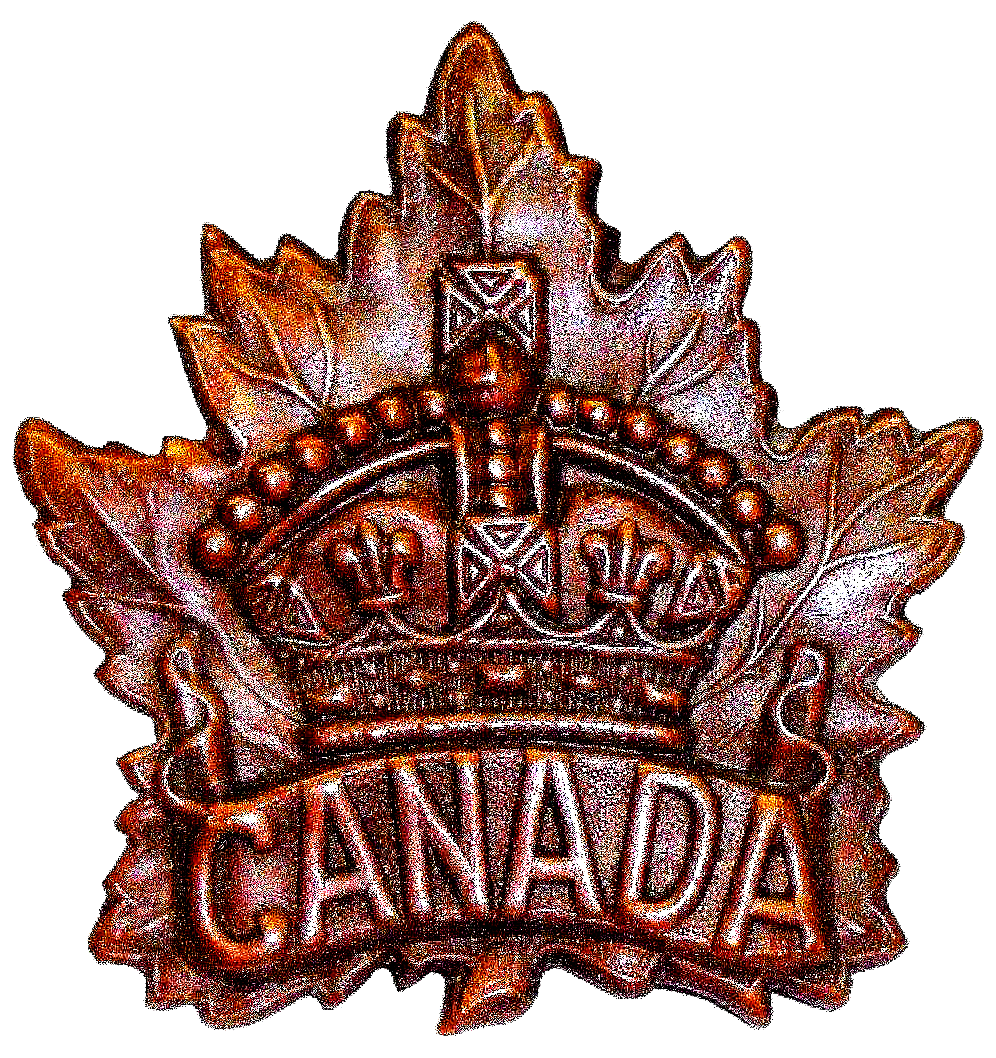
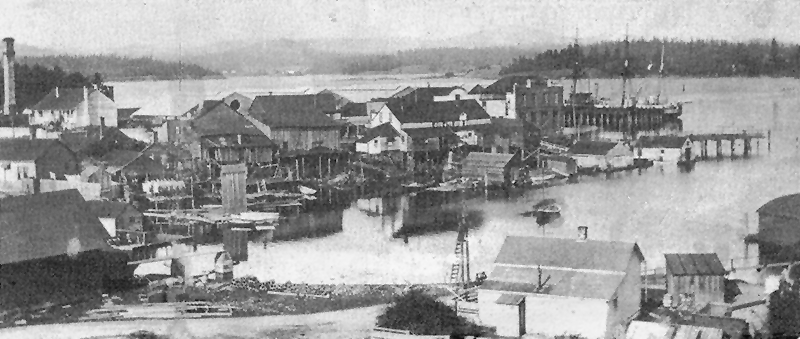
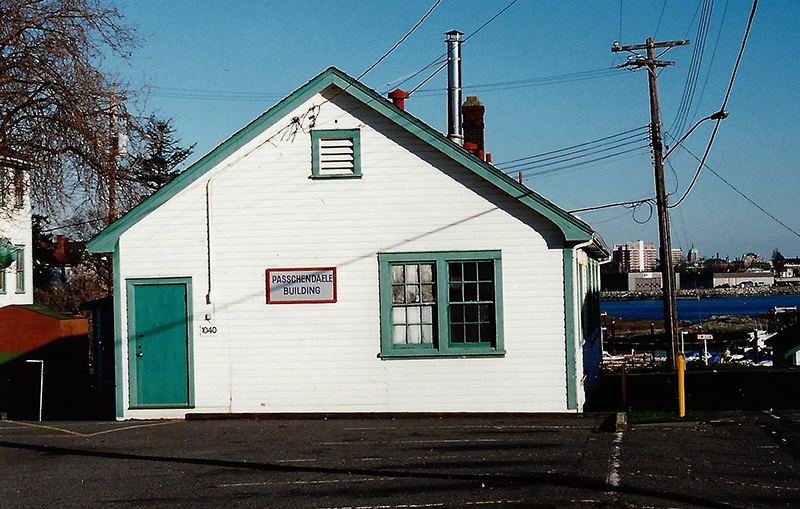
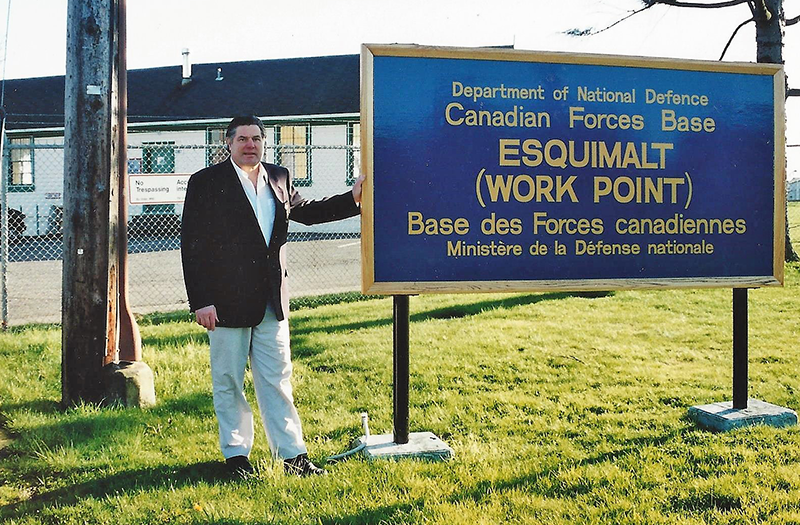
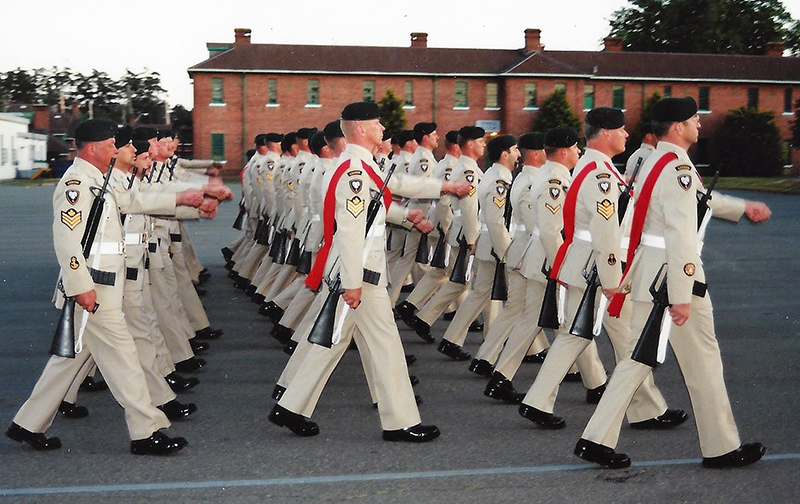
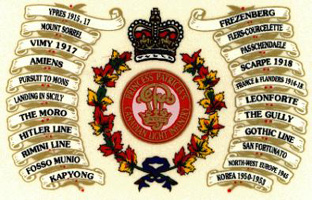
.png)
.png)
.png)
.png)
